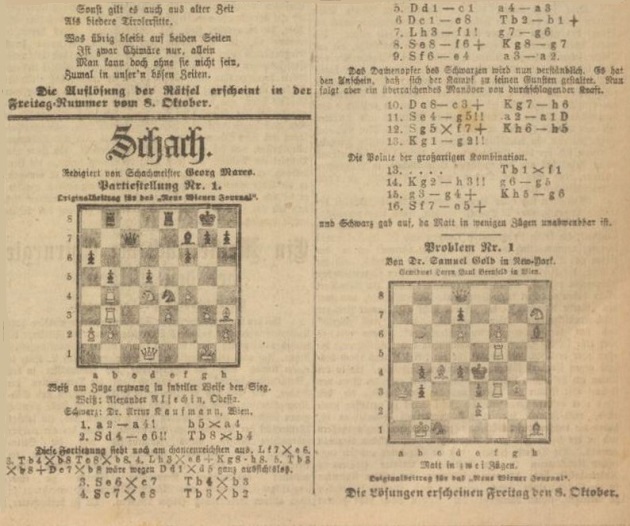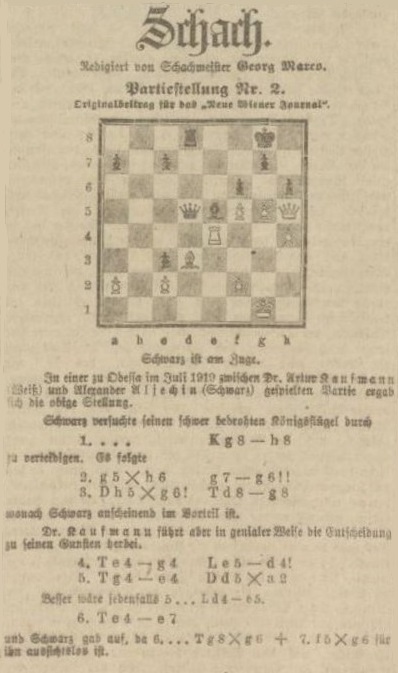Chess Notes
Edward Winter
When contacting us by e-mail, correspondents are asked to include their name and full postal address and, when providing information, to quote exact book and magazine sources. The word ‘chess’ needs to appear in the subject-line or in the message itself.
| First column | << previous | Archives [158] | next >> | Current column |
10575. Smothered mate
A specimen of the smothered mate is supplied by Eduardo Bauzá Mercére (New York, NY, USA), from page 2 of the Washington Post, 28 May 1916:
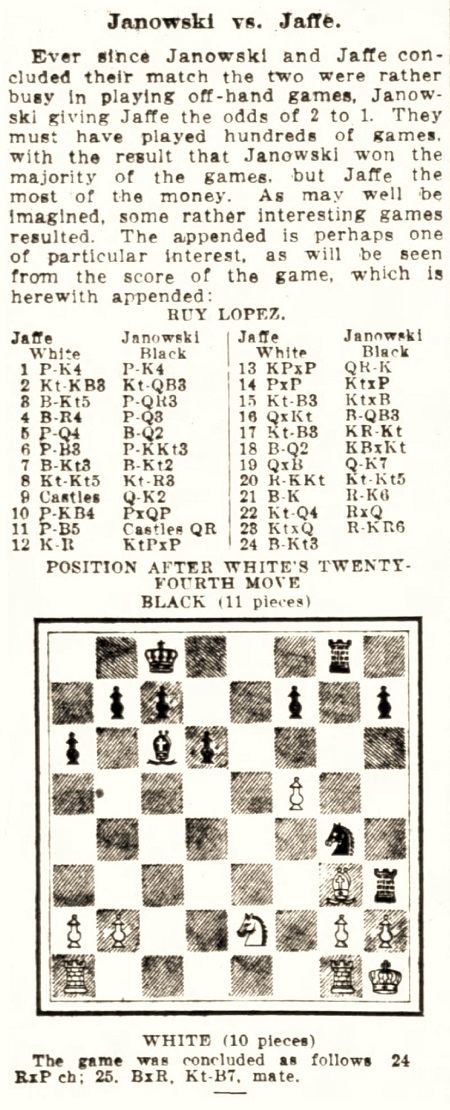
1 e4 e5 2 Nf3 Nc6 3 Bb5 a6 4 Ba4 d6 5 d4 Bd7 6 c3 g6 7 Bb3 Bg7 8 Ng5 Nh6 9 O-O Qe7 10 f4 exd4 11 f5 O-O-O 12 Kh1 gxf5 13 exf5 Rde8 14 cxd4 Nxd4 15 Nc3 Nxb3 16 Qxb3 Bc6 17 Nf3 Rhg8 18 Bd2 Bxc3 19 Qxc3 Qe2 20 Rg1 Ng4 21 Be1
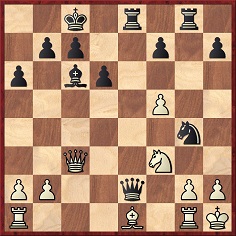
21...Re3 22 Nd4 Rxc3 23 Nxe2 Rh3 24 Bg3 Rxh2+ 25 Bxh2 Nf2 mate.
10576. Cheapo
This game was annotated by Eliot Hearst on page 6 of Chess Life, 5 April 1953:
M. Bronstein – Eliot Hearst
Intercollegiate Team Championship, New York, 1952
Sicilian Defence
1 e4 c5 2 Nf3 d6 3 d4 cxd4 4 Nxd4 Nf6 5 Nc3 a6 6 Bd3 e5 7 Nb3 Be6 8 Be3 Qc7 9 h3 b5 10 Qf3 Nbd7 11 O-O Nb6 12 Bg5 Be7 13 Rad1 O-O 14 Ne2 Nc4 15 Bc1 a5 16 Ng3 a4 17 Nd2 g6 18 Nxc4 bxc4 19 Be2 c3 20 b3 Kg7 21 Bg5 Ng8 22 Bxe7 Nxe7 23 Rd3 Rac8 24 Rfd1 Nc6 25 Nh5+ gxh5 26 Qxh5 f6 27 Rxd6 Qf7 28 R1d3 Nd4 29 Rg3+ Kh8

30 Qxf7
Hearst gave this move a question mark and commented:
‘White falls for a “cheapo”, but the game can no longer be held.’
The remaining moves were 30...Nxe2+ 31 Kh2 Bxf7 32 Re3 Nd4 33 Rxf6 axb3 34 axb3 Nxc2 35 Ref3 Nd4 36 Rxf7 Nxf3+ 37 Rxf3 Rxf3 38 gxf3 c2 39 White resigns.
This is the earliest occurrence of ‘cheapo’ that we recall seeing in a chess context.
In a light-hearted article on page 154 of Chess Life, July 1962 Hearst wrote that the term was coined by the US master Dr Karl Burger, ‘who has won a large percentage of his games by such a maneuver’. Burger, it may be relevant to note, was born in 1933.Page 61 of E.R. Brace’s An illustrated Dictionary of Chess (London, 1977) had nothing better than this:
‘Cheapo (originally, Canadian chess slang) a swindle.’
The online Oxford English Dictionary has only relatively recent citations (1975, 1979 and 1985) for ‘cheapo’ as a noun:

10577. Pillsburial

Position after 15 f5 b4
In a discussion of Pillsbury v Marco, Paris, 1900, this note was on page 66 of American Chess Masters from Morphy to Fischer by Arthur Bisguier and Andrew Soltis (New York, 1974):
‘Black has made logical moves and no obvious positional errors. Yet he is already quite lost. It was games like this, called “Pillsburials”, that put the Queen’s Gambit on the map.’
Who called such games ‘Pillsburials’?
The term ‘A Pillsburial’ appeared on page 149 of the May 1958 Chess Review, in the heading to a Nimzo-Indian Defence game between Bisguier and F. Pérez, Bogotá, 1958. That game is also on pages 181-183 of volume one of The Art of Bisguier (Hazel Crest, 2003).
A full-page inscription by Bisguier in American Chess Masters from Morphy to Fischer:

10578. F.W. Womersley
Still sought: pictures of Frederick William Womersley. The only specimen in Chessplayer Shot Dead in Hastings is a detail from the frontispiece to the November 1899 BCM, which accompanied an article entitled ‘The Hastings Touring Team’:
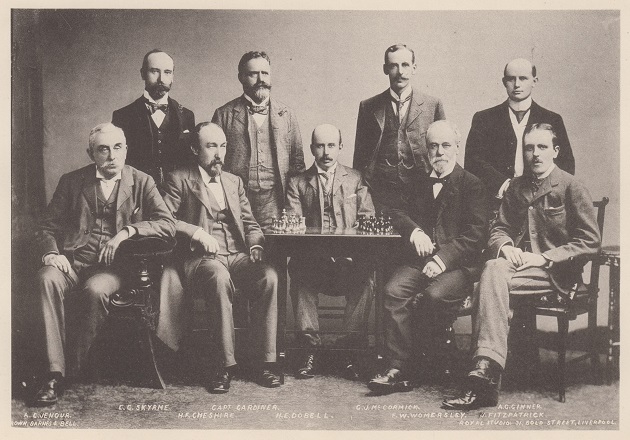
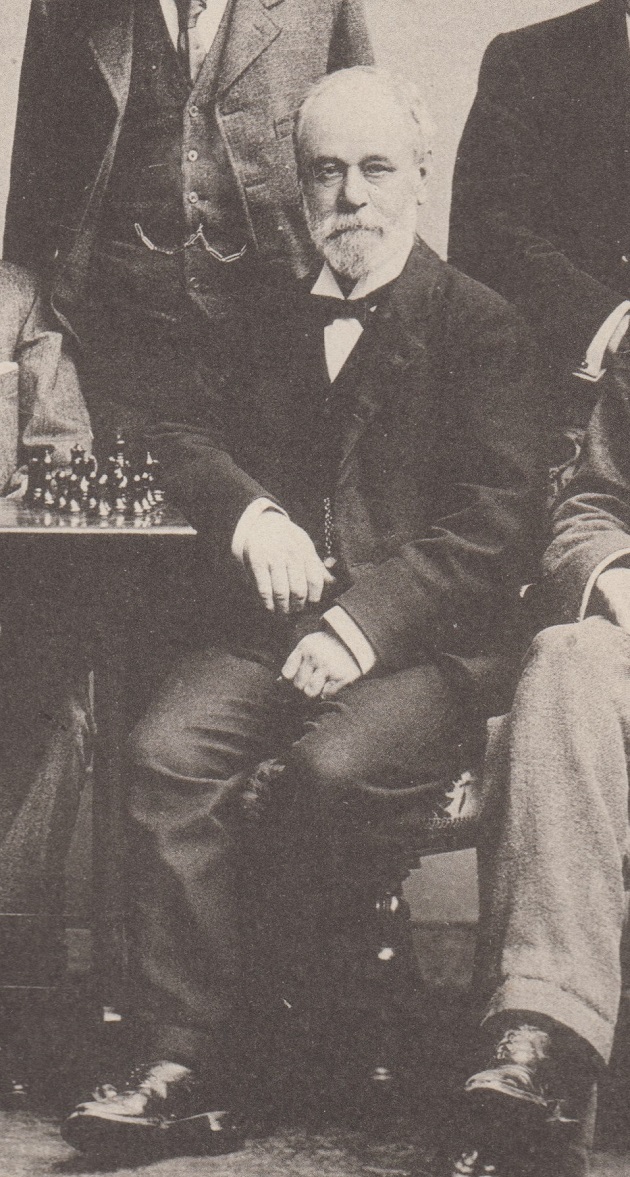
Frederick William Womersley
10579. The BCM
In C.N. 10538 Olimpiu G. Urcan (Singapore) drew attention to an unsigned article on pages 498-499 of the August 2017 BCM entitled ‘Did F.D. Yates Kill Himself?’ which a) misappropriated our writing, b) lifted material from Wikipedia without acknowledgement and c) mistook Emanuel Lasker for Edward Lasker:
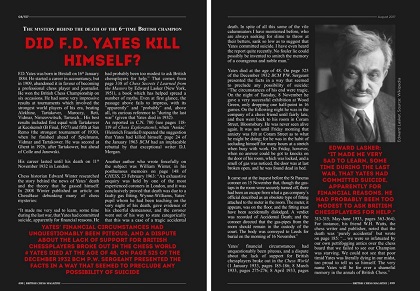
On 5 September 2017 Mr Urcan informed us that page 565 of the September 2017 BCM had this ‘Correction’:
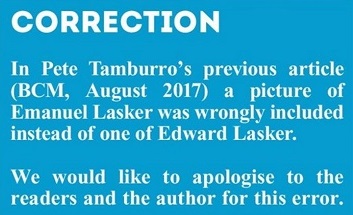
The BCM thus offered not one word of apology for anything other than the Lasker mix-up.
Pete Tamburro (Morristown, NJ, USA) now informs us that, in any case, the correction itself is wrong. His sole contribution to the August 2017 BCM was a separate article on Yates elsewhere in the magazine (‘F.D. Yates and the 5 Bd2 Winawer’, on pages 494-497). The offending article ‘Did F.D. Yates Kill Himself?’ had nothing to do with him.
10580. Bobby Fischer Teaches Chess
Christian Rau (Rüsselsheim, Germany) reports that he owns this copy of Bobby Fischer Teaches Chess:
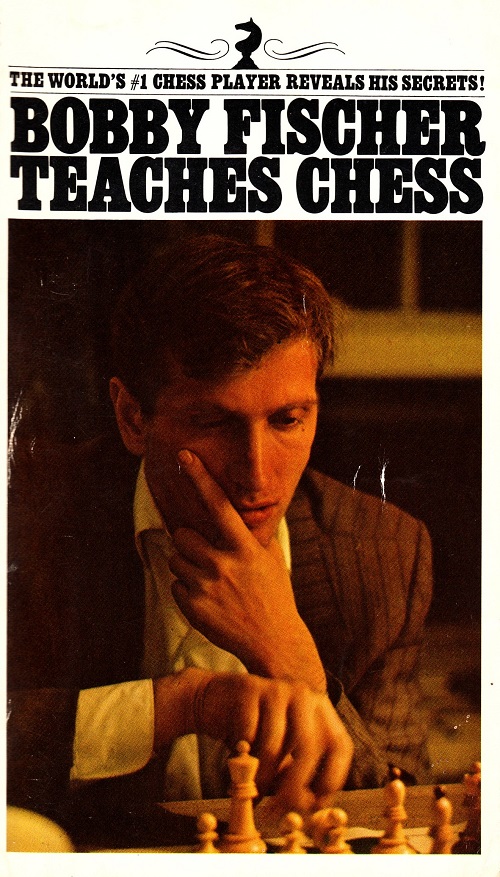

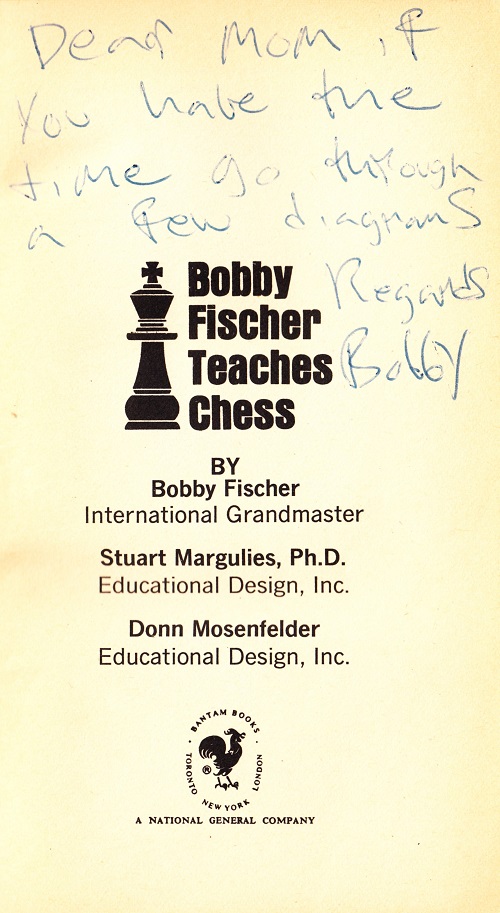
10581. Charousek and the Handbuch (C.N.s 8296 & 10107)
A report from Nuremberg dated 13 August 1896 on page 29 of the Westminster Budget, 21 August 1896 is pointed out by Neil Blackburn (Redditch, England) in connection with this paragraph about Charousek:
‘From the very first day he impressed me with the notion of an extraordinary genius. But for his impetuosity and temerity he would certainly have taken a higher place. He only learned the game five years ago at college, and a single instance will suffice to measure his enthusiasm and perseverance – viz, he copied the German “Handbuch” from beginning to end because, as he tells me, he was not rich enough at school to indulge in the luxury of procuring one.’
10582. A remark ascribed to Capablanca
As an example of quotes which swirl around unaccompanied by a source, Stéphane Pilawski (Hannut, Belgium) points out that the following text has a page to itself at the start of the 2016 translation (by Pascal Golay) Ma Carrière échiquéenne (Capablanca):
‘On n’a jamais que l’âge auquel on a commencé à jouer aux échecs, car après on cesse de vieillir.
José Raúl Capablanca.’
10583. Aristotle and Confucius
The latest feature article is Pre-Chess Chess Quotes.
10584. Cheapo (C.N. 10576)
From Eliot Hearst (Tucson, AZ, USA):
‘Karl Burger did indeed coin the word “cheapo” in its chess usage form. Burger, James Sherwin and I were team-mates on Columbia University’s US college championship teams of 1950-53, and the three of us remained good friends until Karl Burger’s death in 2000. He used “cheapo” to refer to a move that contains a very obvious, unsophisticated threat, and it could apply in either a winning or a lost position. But often it worked.’
10585. Pillsbury v Jacobs
A report about City of London Chess Club activities on page 272 of the June 1902 BCM included the following:
‘... on 12 April Mr H.N. Pillsbury performed the extraordinary feat of playing blindfold against 16 members. The blindfold player won seven games, drew eight with Messrs Allcock, Anspach, Flear, Herbert Jacobs, Loman, Dr Marshall, Park and Wood, and lost to Mr W. Ward.’
The draw against Jacobs was given with Pillsbury’s notes in issue 42 of Womanhood, 1902, page 464:
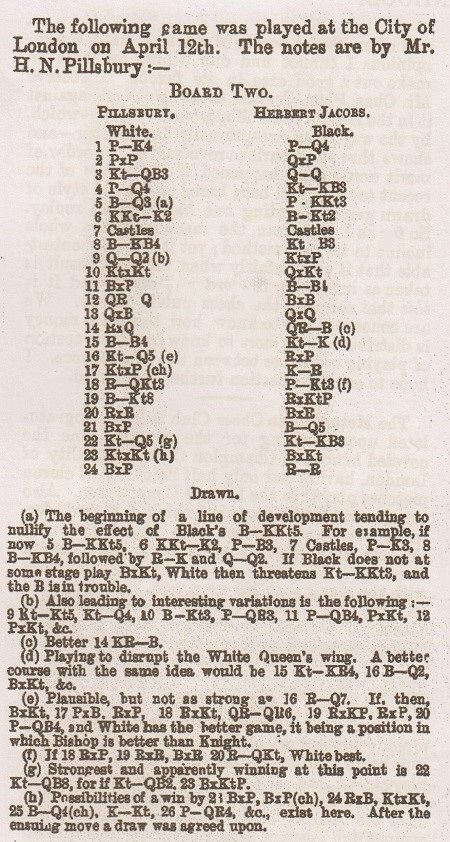
1 e4 d5 2 exd5 Qxd5 3 Nc3 Qd8 4 d4 Nf6 5 Bd3 g6 6 Nge2 Bg7 7 O-O O-O 8 Bf4 Nc6 9 Qd2 Nxd4 10 Nxd4 Qxd4 11 Bxc7 Bf5 12 Rad1 Bxd3 13 Qxd3 Qxd3 14 Rxd3 Rac8 15 Bf4 Ne8
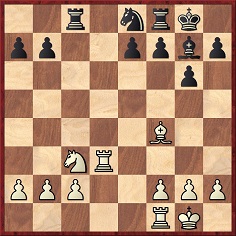
16 Nd5 Rxc2 17 Nxe7+ Kh8 18 Rb3 b6 19 Bb8 Rxb2 20 Rxb2 Bxb2 21 Bxa7 Bd4 22 Nd5 Nf6 23 Nxf6 Bxf6 24 Bxb6 Ra8 Drawn.
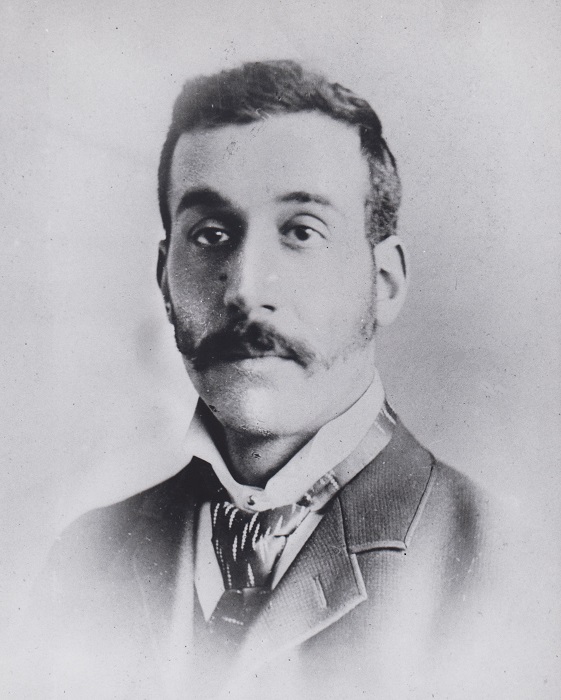
Herbert Jacobs
10586. Kaufmann
and Alekhine
Olimpiu G. Urcan (Singapore) writes:
‘On pages 229-233 of our book Arthur Kaufmann. A Chess Biography, 1872-1938 (Jefferson, 2012) Peter Michael Braunwarth and I presented clues suggesting that Kaufmann met, and played against, Alexander Alekhine in Odessa in June/July 1919. Recently, Dominique Thimognier (Fondettes, France) has discovered incontrovertible proof thereof, in Georg Marco’s chess column in the Neues Wiener Journal. Mr Thimognier points out that in the 2 October 1920 column (page 3) Marco gave a position from the familiar Alekhine v “Dr A. Kaufman” game discussed on pages 230-232 of our book. Black was indeed Arthur Kaufmann:
Furthermore, Mr Thimognier has found that in the 6 October 1920 column in the same newspaper (page 3) Marco gave the conclusion of another game played by Kaufmann and Alekhine (Odessa, July 1919):
Marco presented each item as an “original contribution for the Neues Wiener Journal”.’
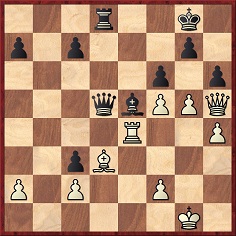
Black to move (Kaufmann v Alekhine, Odessa, July 1919)
1...Kh8 2 gxh6 g6 3 Qxg6 Rg8 4 Rg4 Bd4 5 Re4 Qxa2 6 Re7 Resigns.

10587. Mr and Mrs Blackburne
Wanted: a better version of this photograph, which was published in a very small format on page 393 of the October 1924 BCM:
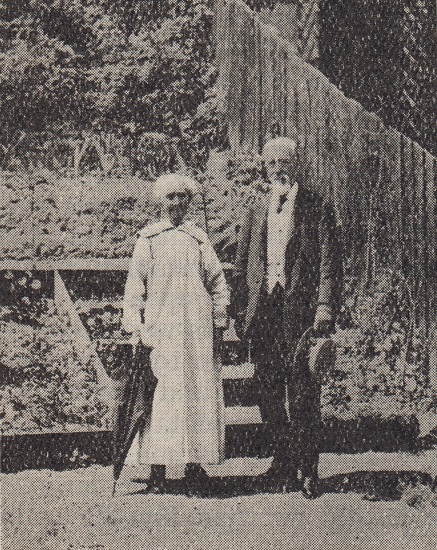
The other known shot of Blackburne in his final years was presented by a correspondent in C.N. 4791.
An obituary of J.H. Blackburne’s wife, née Mary Jane Fox, was on page 50 of the February 1922 BCM.
10588. Aristotle
Concerning the reference to Aristotle in Pre-Chess Chess Quotes, Mike Salter (Sydney, Australia) writes:
‘At Rhetoric I.11.15, Aristotle makes a statement about the desirability of boys participating in games that involve victory, such as “knucklebones, ball-games, dice and πεττεία”, the last of these usually being translated as “draughts”, to which it was apparently similar. An English translation (with the original Greek in a sidebar) is online:
The word πεσσεία/πεττεία (and πεσσοί, the name for the “pieces”) occurs occasionally in Greek literature, perhaps most memorably in a satire by Lucian in which he has the philosopher Heraclitus saying (in a deliberately obscure phrase) that “time” is like “a child playing at πεσσοί”.’
10589. ‘Interred’
From page 55 of The KGB Plays Chess by B. Gulko, V. Popov, Y. Felshtinsky and V. Korchnoi (Milford, 2010):
‘The human rights defenders who were put in psychiatric hospitals were not interred there on the basis of a court ruling, the period of their stay was unspecified and indefinite, and such “patients” never had any rights at all.’
10590. Réti book
Another Chess Book by Richard Réti is our latest feature article.
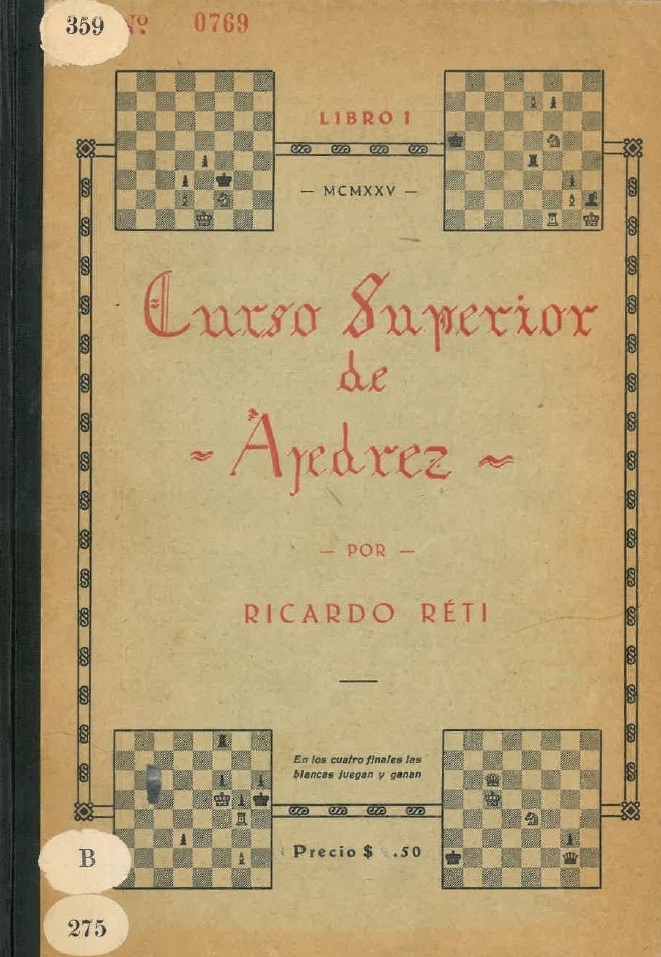
10591. 14...Ng5
Black to move:

Position after 14 hxg4
Black played 14...Bg5, but would 14...Ng5 have been preferable? Evidently not, given that White then wins a piece with 15 Nxe7+.
The position arose in the sixth match-game between Capablanca and Marshall in 1909 in Morristown, NJ (and not New York, as stated in Golombek’s 1947 monograph on the Cuban). From page 36 of Capablanca’s 1920 book My Chess Career:

In the 1966 ‘unabridged and corrected republication’ of My Chess Career from Dover Publications, Inc. the text was the same, although on page 34.
A particular surprise is that Capablanca’s note was reproduced unquestioningly on page 227 of the first volume of Kasparov’s Predecessors series:

Various translations of Capablanca’s book (into Russian, Serbo-Croat, Czech and Spanish) gave the same note, but page 61 of the 2016 French edition (C.N. 10582) had a translator’s footnote:
‘Il semble que sur 14...Cg5, Capablanca ait oublié 15 Ce7+ qui gagne une pièce pour les Blancs. Peut-être veut-il dire 14...Cf6.’
Capablanca may indeed have meant 14...Nf6, and not 14...Ng5. The existence of the move ‘Kt-Kt4’ in the previous note could have led to a typesetting mistake.
A faulty game-score seems an unlikely explanation, the previous moves being well established from publications of the time. They include pages 187-188 of the 8 May 1909 Chess Weekly, which had Capablanca’s exclusive annotations (with no comment at move 14):
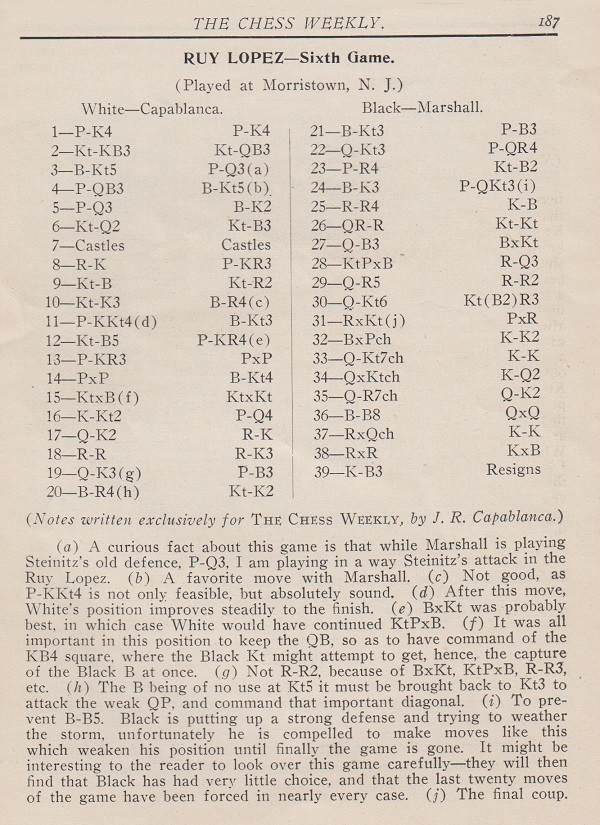

Page 49 of volume one of the 1997 ‘Chess Stars’ work on Capablanca followed 14...Bg5 with a brief note, ‘14...Ng5?? 15 Ne7 +–’, but did not mention that Black’s move had been put forward in My Chess Career. When was the ‘14...Kt-Kt4’ mistake in Capablanca’s book first pointed out?
10592. Curt von Bardeleben (C.N. 5999)
C.N. 5999 asked for corroboration of claims by Edward Lasker on pages 20-21 of Chess Secrets I Learned from the Masters (New York, 1951) about Curt von Bardeleben:
‘He always wore a black cut-away suit of dubious vintage. Apparently he could never spare enough money to buy a new suit, although I learned one day that at fairly regular intervals he received comparatively large sums – from one to several thousand marks – through the simple expedient of marrying, and shortly after divorcing, some lady who craved the distinction of his noble name and was willing to pay for it. Unfortunately, when he received his reward, it was usually far exceeded by the amount of the debts he had accumulated since his last divorce. Evil tongues had it that the number of the ladies involved in these brief marital interludes had grown so alarmingly that they could easily have made up a Sultan’s harem.’
Richard Forster (Zurich) writes:
‘I have checked the civil records available at Ancestry.com (Berlin, Germany, Marriages, 1874-1920. Provo, UT, USA: Ancestry.com Operations, Inc., 2014), the original data being from the Landesarchiv, Berlin.
These records confirm, at least partly, Edward Lasker’s story, as they show that Curt von Bardeleben married ten times between 1902 and 1919:
- 13 September 1902-19 December 1903: Hedwig Beyer (born 24 June 1870; died 10 June 1959);
- 18 April 1906-20 October 1906: Katharina Kastenmayer (born 8 February 1875);
- 12 February 1907-12 July 1907: Heinriette Elisabeth Boehnke (born 5 September 1857);
- 19 August 1907-13 March 1915: Charlotte Luise Therese Michel (born 3 May 1886);
- 24 April 1915-21 July 1915: Ilse Marie Auguste Sack (born 17 February 1891);
- 25 February 1916-27 June 1916: Martha Helene Goetsch (born 4 November 1869);
- 20 November 1916-21 May 1917: Rosa Ida Hedwig Krüger (born 13 August 1879);
- 14 June 1917-13 June 1918: Marie Elisabeth Thierau (born 8 April 1888);
- 1 August 1918-8 February 1919: Anna Luise Lange (born 6 June 1892);
- 25 February 1919: Auguste Anna Ida Schulz (born 18 December 1877).’
10593. Fink v Gruer
From page 10 of the Staten Islander, 29 September 1920 Eduardo Bauzá Mercére (New York, NY, USA) sends this offhand game:
Adolf Jay Fink – Elmer Walker Gruer
San Francisco? Date?
Ruy López
1 e4 e5 2 Nf3 Nc6 3 Bb5 a6 4 Ba4 Nf6 5 O-O Be7 6 Re1 b5 7 Bb3 d6 8 c3 Na5 9 Bc2 c5 10 d3 Nc6 11 Nbd2 Qc7 12 a4 Rb8 13 Nf1 d5 14 Ne3 Be6 15 Qe2 d4 16 Nd5 Qd8 17 axb5 axb5 18 Ra6 Qc8
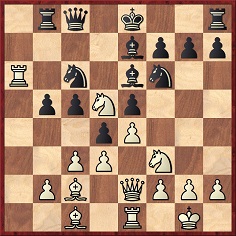
19 Rxc6 Qxc6 20 Nxe5 Qb7 21 Nxe7 Kxe7 22 cxd4 cxd4 23 f4 Rhd8 24 Bd2 Kf8 25 f5 Bd7 26 Bb4+ Kg8
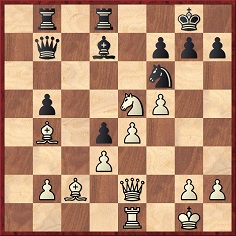
27 Nxf7 Kxf7 28 Bb3+ Ke8 29 e5 Nd5 30 Qh5+ g6 31 fxg6 Be6 32 Bd6 Nf6 33 gxh7+ Nxh5 34 h8(Q)+ Kd7 35 Qh7+ Kc6 36 Rc1+ Bc4 37 Qe4+ Kd7 38 Qf5+ Kc6
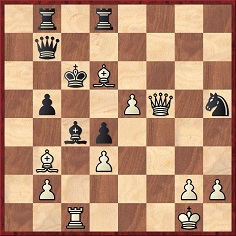
39 Bxc4 Rxd6 40 Bd5+ Kxd5 41 e6 mate.
C.N. 3594 gave a photograph of Fink. A portrait of Gruer accompanied his obituary on page 158 of the American Chess Bulletin, September-October 1931:
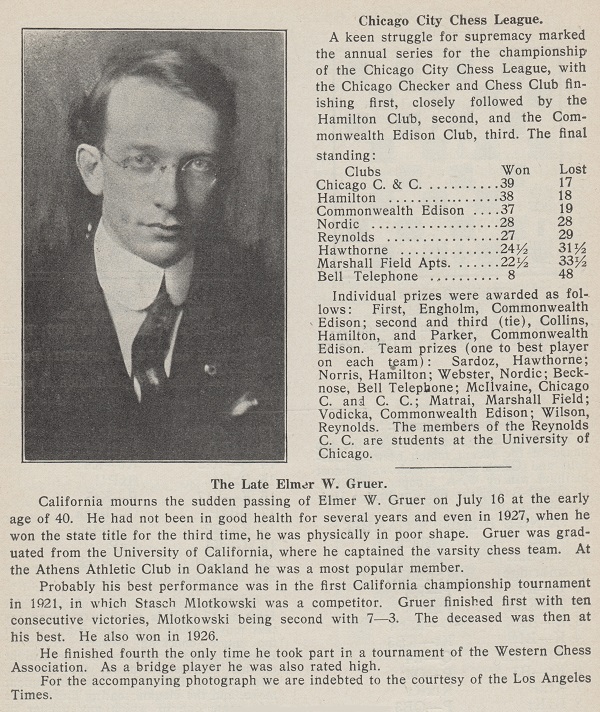
10594. Réti book (C.N. 10590)
Miquel Artigas (Sabadell, Spain) reports that he owns a different edition of Suplemento al curso superior de ajedrez, published in 1930:
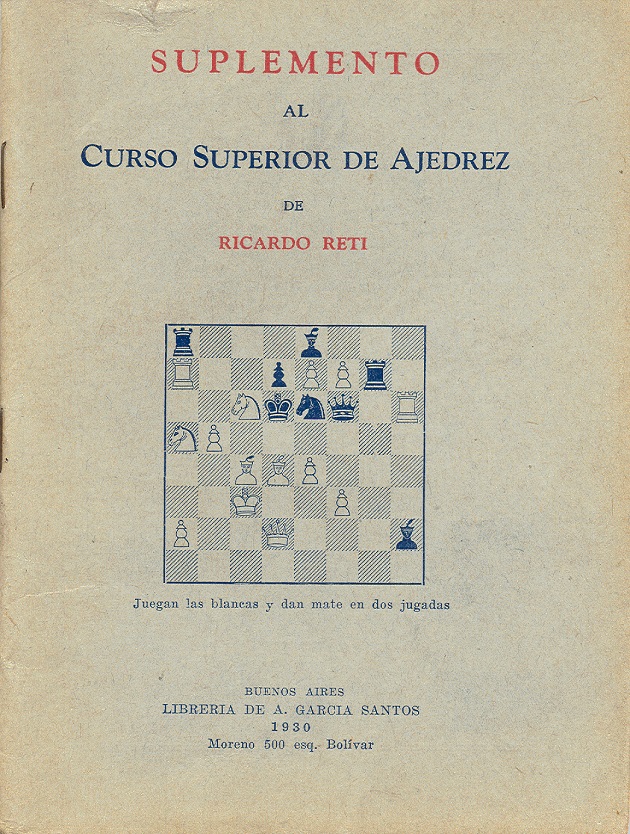
10595. 14...Ng5 (C.N. 10591)
Vitaliy Yurchenko (Uhta, Komi, Russian Federation) notes that page 35 of volume one of José Raúl Capablanca Avtoportret genia by S. Voronkov (Moscow, 2006) stated outright, in quoting Capablanca’s remark about 14...Ng5, that he overlooked the reply 15 Nxe7+:
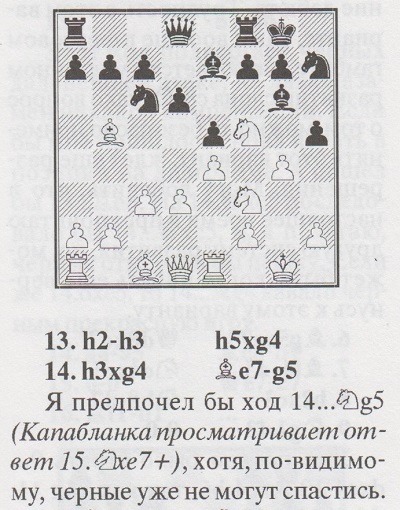
10596. Guinness World Records
As regards our annual scrutiny of Guinness World Records, the 2018 volume is now to hand. After the two pages for chess last year (C.N. 10110), how would the game fare in the new book (promoted on the back cover as ‘The super-est edition yet!’)?

The answer is that chess is back to where it was two years ago: nothing.
In compensation, the reader will find entries on such feats as the ‘most flowers picked with the mouth in a contortion backbend in one minute’, the largest collection of ‘banana-related memorabilia’, the most ‘cream-filled biscuits stacked in 30 seconds’, the ‘most shuttlecocks caught with chopsticks in one minute’, the ‘largest online photo album of people giving a thumbs-up’, the ‘most valuable bra’, the ‘first written record of black pudding’ and the ‘largest origami rhinoceros’.
10597. Isaacs v Buerger (C.N. 9027)
Eduardo Ramirez (Chicago, IL, USA) draws attention to the analysis by Alekhine on pages 102-103 of the March 1927 BCM:
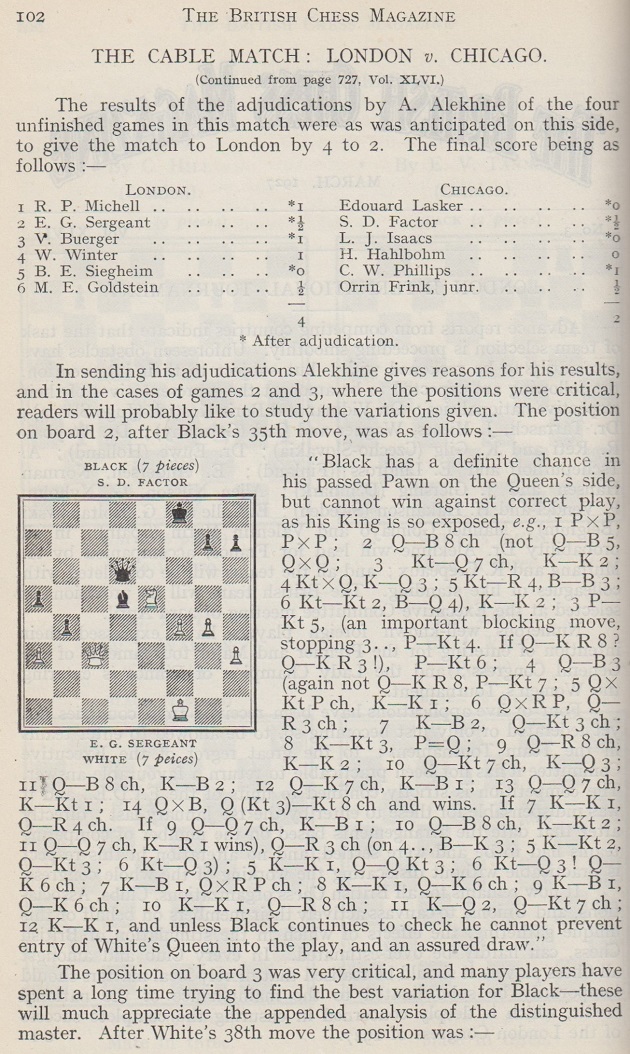
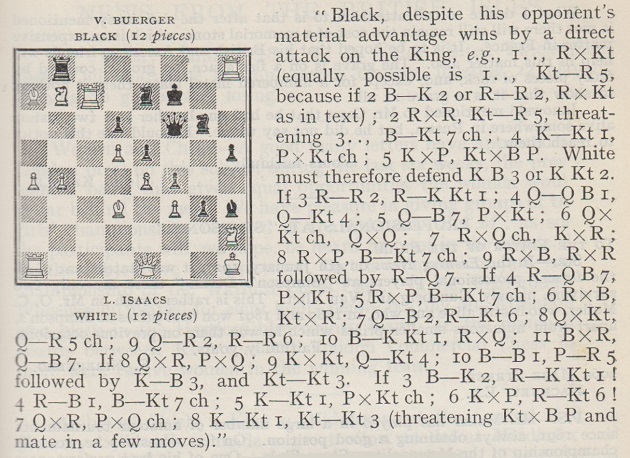
10598. Photograph caption
A number of items (C.N. 9606, for instance) have mentioned the dismal stock caption about X and Y ‘sharing (or enjoying) a joke’. Variations on the theme are always welcome, and below is a picture from opposite page 20 of Chess Springbok by Wolfgang Heidenfeld (Cape Town, 1955):
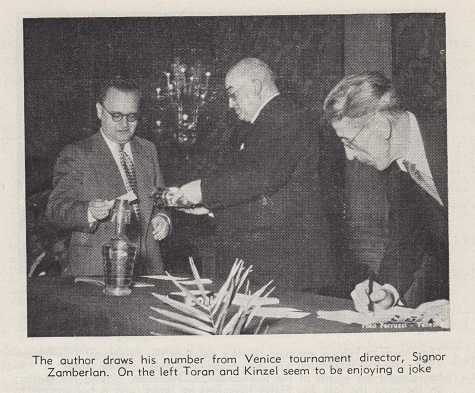
10599. Herman Steiner and William Primrose
Frank Camaratta (Huntsville, AL, USA) asks whether photographs are available of Herman Steiner with the violist William Primrose (1904-82).
Adding that Steiner’s chessmen were used in a number of high-profile events in the 1950s and 60s, including the Fischer v Reshevsky match and the Piatigorsky Cup, our correspondent provides two photographs, taken with the agreement of the Steiner family, as well as a shot of Petrosian playing with the set.
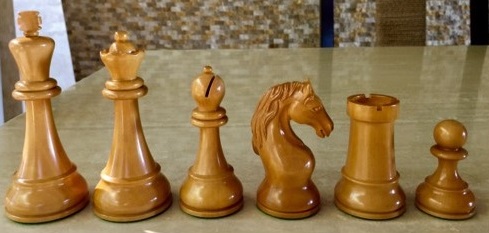
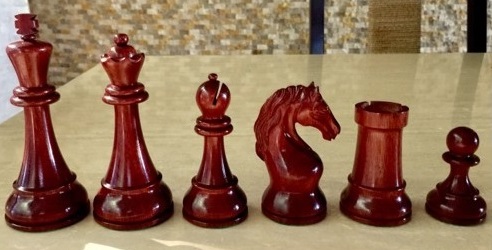
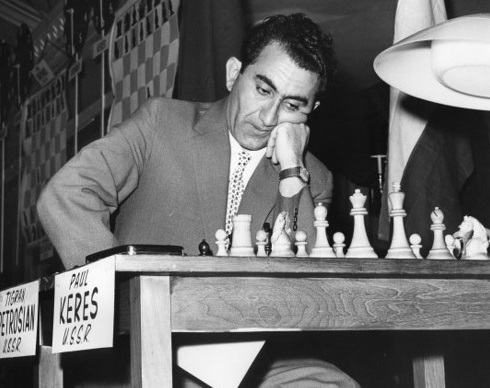
10600. Louis Persinger
C.N. 3912 reported that in one of our copies of The Golden Treasury of Chess by Francis J. Wellmuth (New York, 1943) the eminent musician Louis Persinger wrote on the first page of the Index of Players ‘I’ve played against – ’ and ticked these names: W. Adams, Alekhine, Battell, S. Bernstein, Borochow, Capablanca, Chernev, Dake, Denker, Donovan, Fine, Fish, Fonaroff, Fulop, Grabill, Hanauer, Helms, Hidalgo, Horowitz, Kashdan, Koltanowski, Korpanty, Ed. Lasker, Em. Lasker, Marshall, Platz, Polland, Reinfeld, Reshevsky, H. Steiner, Tenner, Testa, Ulvestad and Woskoff.
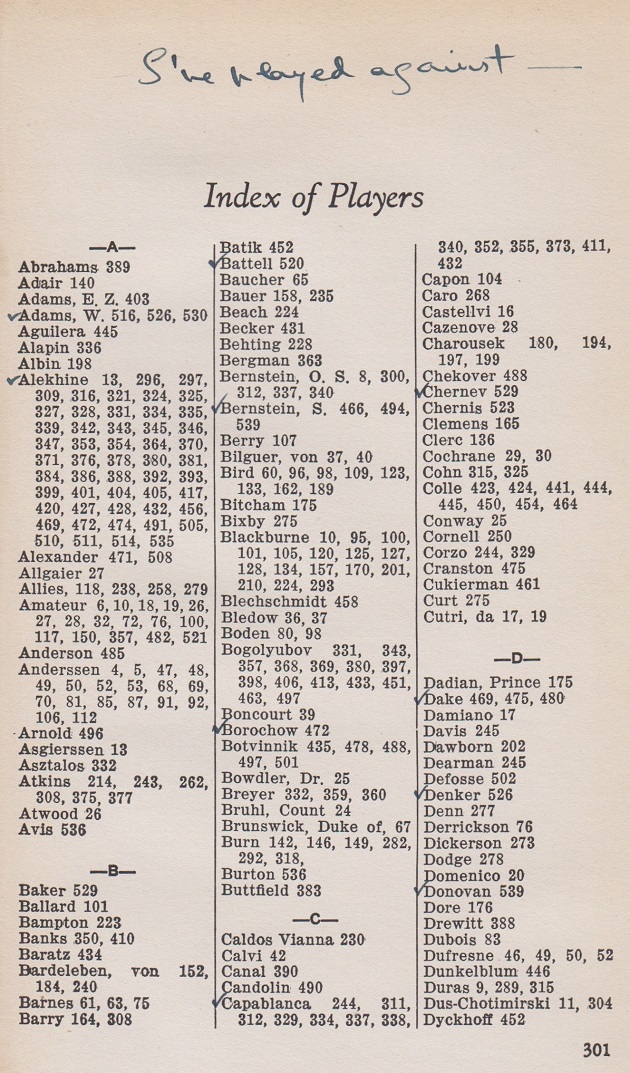
From page 210 of the July 1961 Chess Life, in an article by Persinger entitled ‘Chess and Music’:


Can any non-masters claim a comparable record?
10601. Games and matches
Journalists who pay a flying visit to the chess world often muddle the terms ‘game’ and ‘match’, but confusion may even slip into chess books. It may be wondered who wrote the final paragraph of the unsigned Introduction to Chess: Games to Remember by I.A. Horowitz (London, 1973):
‘This book does not include the matches in the World Championship in Iceland in the late summer, 1972.’
10602. Beginner’s Guide to Chess
From the dust-jacket of the Horowitz volume (published by Pelham Books, London) mentioned in the previous item:
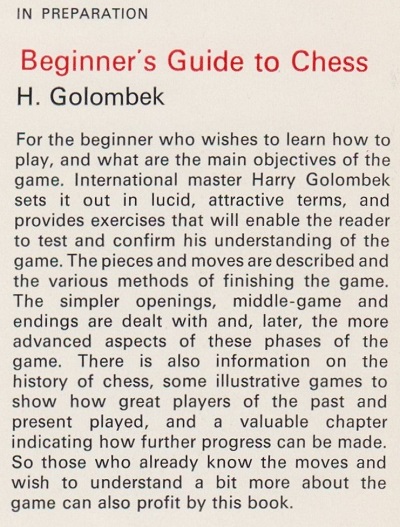
No such book is on record, although in 1981 Penguin Books brought out Beginning Chess by Harry Golombek.
A snippet from the Introduction (page 7):
‘I have known one real mathematical genius in my life and he, while passionately fond of chess, played it atrociously. I could give him the odds of a queen (the most powerful piece in the game) and still beat him.’
The penultimate paragraph on the same page:
‘Chess does indeed have some therapeutic value in the matter of training the mind; it helps to concentrate the mind wonderfully. But so, according to Dr Johnson, does the prospect of being hanged next day [sic].’
10603. Herman Steiner and William Primrose (C.N. 10599)
Frank Camaratta now has a photograph of Herman Steiner with William Primrose and will include it in an article on Steiner which he is currently writing.
| First column | << previous | Archives [158] | next >> | Current column |
Copyright: Edward Winter. All rights reserved.
